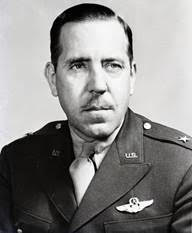Robert Boyd Williams was a Major General in United States Army Air Forces and Commanding General, Second Air Force, headquartered in Colorado Springs, CO.
Early Life
Williams was born in Albany, Texas in 1901. He graduated from Texas A&M College with a Bachelor of Science degree in Civil Engineering in 1923. He was commissioned as a second lieutenant in the Army Air Service on June 6, 1923. Williams entered flying training in June 1923 at Brooks Field in San Antonio. In January 1924, he began advanced flying training at nearby Kelly Field.
Williams then served as Squadron Adjutant at Kelly Field and attended the Photography Course at the Air Service Technical School at Chanute Field, Illinois. From 1925 to 1926, Williams served with the 5th Observation Squadron at Mitchel Field in New York.
Williams was then transferred to France Field in the Panama Canal Zone, where he served with the 6th Composite Group and the 7th Observation Squadron. In 1928, he made an emergency landing in a crater lake in El Salvador. He was flying an OA-4 Dolphin and spiraled his plane out of this hazardous area after refueling. While in Panama he married Amy Ruth MacIntyre.
In May 1930, Williams and Amy returned to the U.S. He spent time as a flight instructor, until 1936, when he attended the U.S. Army Command and General Staff School in Kansas. In 1937, he became the Operations Officer of the 2nd Bombardment Group, at Langley Field in Virginia. The 2nd Bomb Group received the first 12 B-17 Flying Fortresses delivered to the Air Corps in March of 1937.
In May of 1938, Williams was assigned to the 49th Bombardment Squadron at Langley Field and became the Squadron Commander the following year. He then spent time (September 1940 to January 1941), as a military observer in England, witnessing the Battle of Britain and RAF tactics.
He briefly served as the Commanding General of the 16th Bombardment Wing in April of 1943 in El Paso, Texas, before becoming the Commanding General of the 1st Bomb Command. In June of 1943 he was deployed to the 8th Air Force in Great Britain, subsequently becoming the Commanding General of the 1st Bombardment Division.
Manhattan Project
Upon his return to the U.S. Williams was appointed Commanding General of Second Air Force, replacing General Uzal Ent, who was severely injured in an airplane crash. The primary mission of Second Air Force was the training of Heavy and Very Heavy bombardment groups, and replacement crews.
At that time, the Manhattan Project was in its beginning stages at Wendover Field. The 393rdSquadron combat element had already relocated but the task of forming and acquiring the rest of the composite group elements of the 390th Air Service Group: the 603rd Air Engineering Squadron, the 1027th Air Materiel Squadron, the 320th Troop Carrier Squadron, the 1395th Military Police Company, and the First Ordnance Squadron, still lay ahead.
All equipment and manning tables still had to be processed through the 2nd Air Force Headquarters with General Williams’ approval. Even after the 509th CG deployed to Tinian, Williams continued to support the 216th Flight Test Section, and the Special Ordnance Detachment at Wendover, as the Los Alamos weapons development program expanded. Williams remained CG of Second Air Force until November 1945.
Williams spent his retirement years living in San Antonio, Texas until his death from a heart attack at the age of 75. He received the following awards and decorations: a Distinguished Service Cross, a Distinguished Service Medal, an American Defense Service Medal, an American Theater Medal, a WWII Victory Medal, a European–African–Middle Eastern Campaign Medal, and a Brazilian Order of the Southern Cross.





